Where in the Bible Does It Say Modern Day Iraq Will Be Great Again
"Buddha" ways "one who is awake." The Buddha who lived 2,600 years ago was not a god. He was an ordinary person, named Siddhartha Gautama, whose profound insights inspired the world.
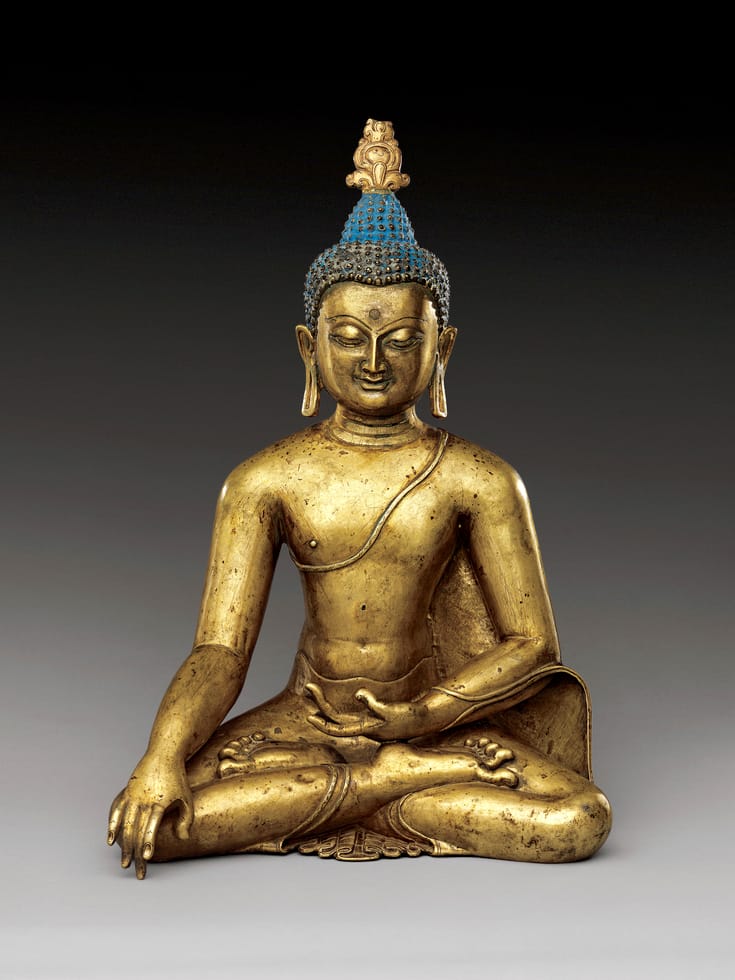
Sculpture of Shakyamuni Buddha touching the world at the moment he reached enlightenment. 11th-twelfth century, Central Tibet. Brass with colored pigments. Photo courtesy of The Met.
Contents
- Who Was Buddha?
- What Practice Nosotros Know About the Historical Buddha?
- Take There Been Other Buddhas?
- What Nearly the Buddhas in Buddhist Fine art?
- Practice Buddhists Worship the Buddha?
- What Did the Buddha Teach?
- What Is Enlightenment?
- Is There a Buddhist Bible?
- Additional Reading
Who Was Buddha?
Buddha is non a name, but a title. Information technology is a Sanskrit discussion that ways "a person who is awake." What a buddha is awake to is the true nature of reality.
Simply put, Buddhism teaches that nosotros all live in a fog of illusions created by mistaken perceptions and "impurities" — hate, greed, ignorance. A buddha is one who is freed from the fog. Information technology is said that when a buddha dies he or she is non reborn but passes into the peace of Nirvana, which is not a "heaven" just a transformed state of existence.
Most of the fourth dimension, when someone says the Buddha, it's in reference to the historical person who founded Buddhism. This was a homo originally named Siddhartha Gautama who lived in what is now northern India and Nepal nigh twenty-five centuries agone.
What Do We Know Well-nigh the Historical Buddha?
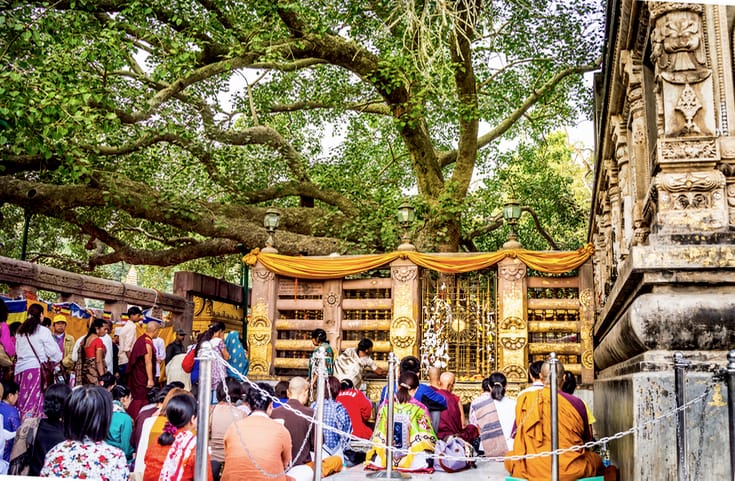
The Bodhi Tree, where the Buddha attained enlightenment, in Bodhgaya, Bharat. Photo past Margie Barbarous.
The traditional story begins with Siddhartha Gautama'southward birth in Lumbini, Nepal, in about 567 BCE. He was the son of a male monarch, raised in sheltered opulence. He married and had a son.
Prince Siddhartha was xx-nine years old when his life changed. In railroad vehicle rides outside his palaces he first saw a sick person, and then an old man, so a corpse. This shook him to the core of his beingness; he realized that his privileged status would not protect him from sickness, old age, and death. When he saw a spiritual seeker — a mendicant "holy man" ― the urge to seek peace of mind arose in him.
He saturday in meditation beneath "the Bodhi tree" until he realized enlightenment.
The prince renounced his worldly life and began a spiritual quest. He sought teachers and punished his torso with austere practices such as extreme, prolonged fasts. It was believed that punishing the body was the way to elevate the listen and that the door to wisdom was plant at the edge of decease. Even so, after six years of this, the prince felt only frustration.
Somewhen, he realized that the path to peace was through mental subject field. At Bodh Gaya, in the modern Indian state of Bihar, he sat in meditation below a ficus tree, "the Bodhi tree," until he awakened, or realized enlightenment. From that time on, he would be known as the Buddha.
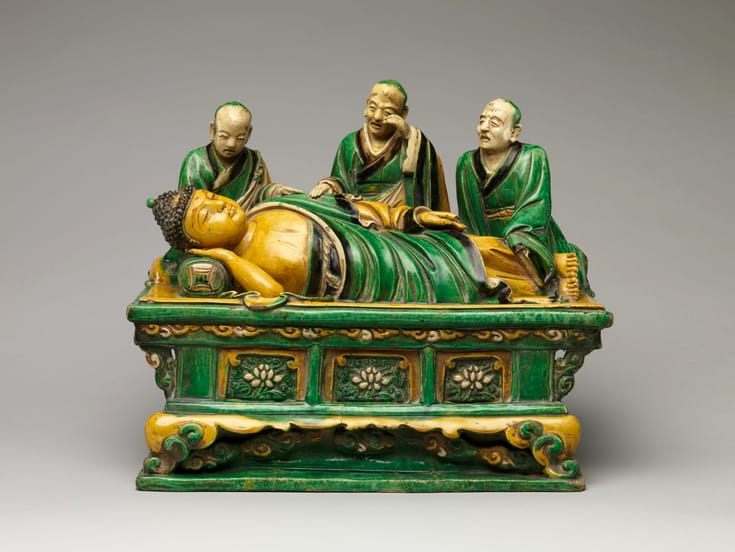
Stoneware sculpture of the Buddha attaining concluding transcendence, known as parinirvana, as he died. c. 1503, by Qiao Bin. Photo courtesy The Met.
He spent the residue of his life didactics people how to realize enlightenment for themselves. He gave his showtime sermon in modern-day Sarnath, near Benares, and then walked from village to village, attracting disciples along the way. He founded the original order of Buddhist nuns and monks, many of whom became nifty teachers likewise. He died in Kushinagar, located in what is now the state of Uttar Pradesh in northern India, about 483 BCE.
The traditional story of the Buddha's life may not be factually accurate; nosotros have no way to know for sure. Historians today generally hold there was a historical Buddha, and that he lived onetime in the 4th through sixth centuries BCE, give or have. Information technology's believed that at to the lowest degree some of the sermons and monastic rules recorded in the oldest scriptures are his words, or something close to his words. But that'south as far as nigh historical scholars volition go.
Have There Been Other Buddhas?
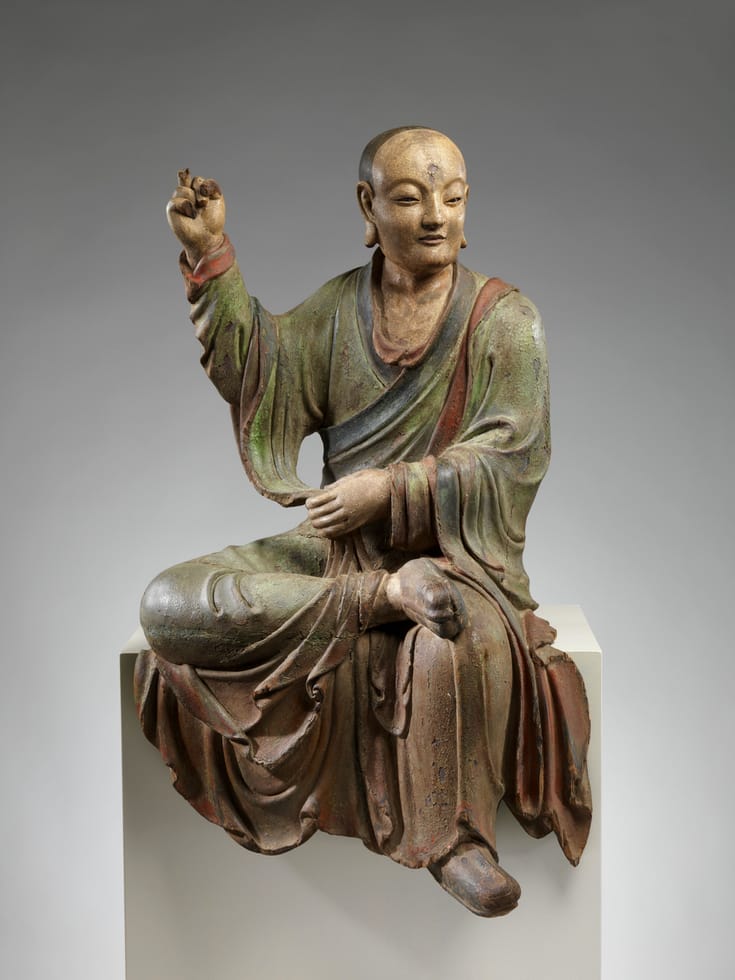
1 of the Buddha's arhats. 19th century, China. Woods with pigment. Photo courtesy of The Met.
In Theravada Buddhism ― the ascendant school of southeast Asia ― information technology is thought at that place is merely one buddha per age of humankind; each age is an unimaginably long time. The buddha of the current age is the historical Siddhartha Gautama. Another person who realizes enlightenment inside this age is not chosen buddha. Instead, he or she is an arhat (Sanskrit) orarahant (Pali) — "worthy ane" or "perfected one." The master difference between an arhat and a buddha is that merely a buddha is a earth instructor, the one who opens the door for all others.
Early scriptures proper noun others who lived in the unimaginably long-ago earlier ages. There is likewise Maitreya, the hereafter Buddha who volition appear when all memory of our Buddha'south teachings has been lost.
There are other major traditions of Buddhism, called Mahayana and Vajrayana, and these traditions put no limits on the number of buddhas there can be. However, for practitioners of Mahayana and Vajrayana Buddhism the ideal is to exist a bodhisattva, one who vows to remain in the globe until all beings are aware.
What About Buddhas in Buddhist Art?
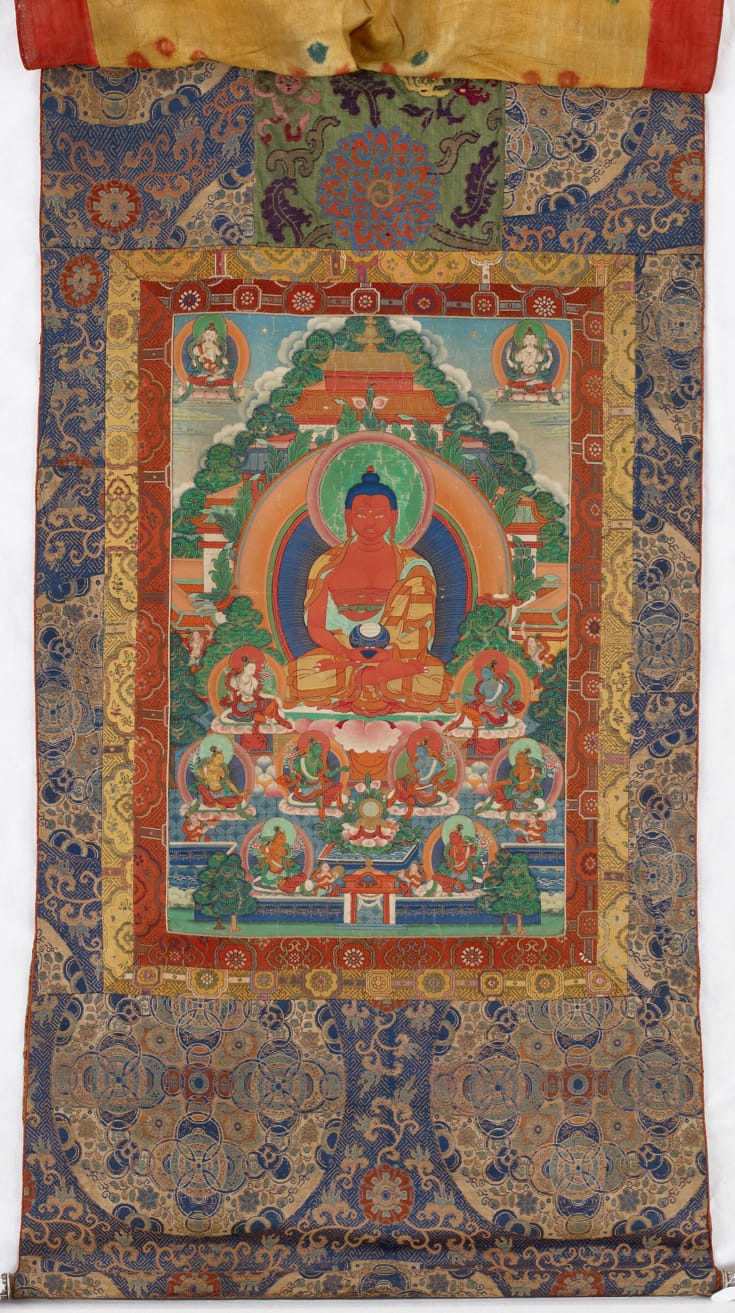
Amitabha in Sukhavati. Thangka from Fundamental Tibet. Courtesy of Freer Sackler.
There are multitudes of buddhas, especially in Mahayana and Vajrayana scriptures and art. They stand for aspects of enlightenment, and they also represent our ain deepest natures. Some of the better known iconic or transcendent buddhas include Amitabha, the Buddha of Boundless Light; Bhaiṣajyaguru, the Medicine Buddha who represents the power of healing; and Vairocana, the universal or primordial Buddha who represents absolute reality. The mode the buddhas are posed too convey particular meanings.
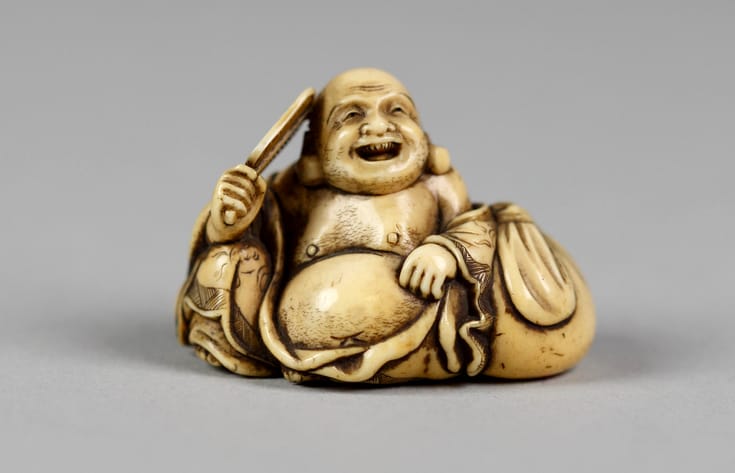
A small sculpture of Hotei, the laughing monk normally misidentified as the historical Buddha. 19th century, Nippon. Photo courtesy of The Met.
The bald, stubby, laughing fellow many Westerners call back of as Buddha is a character from 10th-century Chinese folklore. His name is Budai in Red china, or Hotei in Japan. He represents happiness and abundance, and he is a protector of children and the sick and weak. In some stories he is explained as an emanation of Maitreya, the time to come Buddha.
Exercise Buddhists Worship Buddha?
The Buddha was not a god, and the many iconic figures of Buddhist fine art are not meant to represent godlike beings who will do y'all favors if you worship them.
The Buddha was said to be critical of worship, in fact. In one scripture (Sigalovada Sutta, Digha Nikaya 31) he encountered a young homo engaged in a Vedic worship practice. The Buddha told him it'southward more important to alive in a responsible, ethical way than to worship anything.
You might call up of worship if you see Buddhists bowing to Buddha statues, but at that place'due south something else going on. In some schools of Buddhism, bowing and making offerings are physical expressions of the dropping away of a selfish, ego-centered life and a commitment to practice the Buddha's teachings.
What Did the Buddha Teach?

The dharmachakra, or "cycle of the dharma," which represents the teaching of the Buddha's Noble Eightfold Path. 13the Century, Nihon. Gilt bronze. Photo courtesy of The Met.
When the Buddha achieved enlightenment, he also realized something else: that what he'd perceived was then far exterior ordinary experience that it couldn't entirely exist explained. And then, instead of teaching people what to believe, he taught them to realize enlightenment for themselves.
The foundational teaching of Buddhism is the Four Noble Truths. Very briefly, the Start Truth tells us that life is dukkha, a discussion that doesn't translate neatly into English language. It is often translated as "suffering," but information technology too ways "stressful" and "unable to satisfy."
The 2d Truth tells us dukkha has a crusade. The firsthand crusade is peckish, and the craving comes from not agreement reality and non knowing ourselves. Because we misunderstand ourselves we are riddled with anxiety and frustration. We feel life in a narrow, self-centered way, going through life craving things we think will make us happy. But we notice satisfaction only briefly, and so the anxiety and craving starting time once more.
The Third Truth tells us we tin can know the cause of dukkha and be liberated from the hamster wheel of stress and craving. Merely adopting Buddhist beliefs volition not accomplish this, however. Liberation depends on one's own insight into the source of dukkha. Craving will not stop until y'all realize for yourself what's causing it.
The Fourth Truth tells us that insight comes through practice of the Noble Eightfold Path. The Eightfold Path might be explained every bit an outline of 8 areas of exercise ― including meditation, mindfulness, and living an ethical life that benefits others ― that will help united states alive happier lives and find the wisdom of enlightenment.
What is Enlightenment?
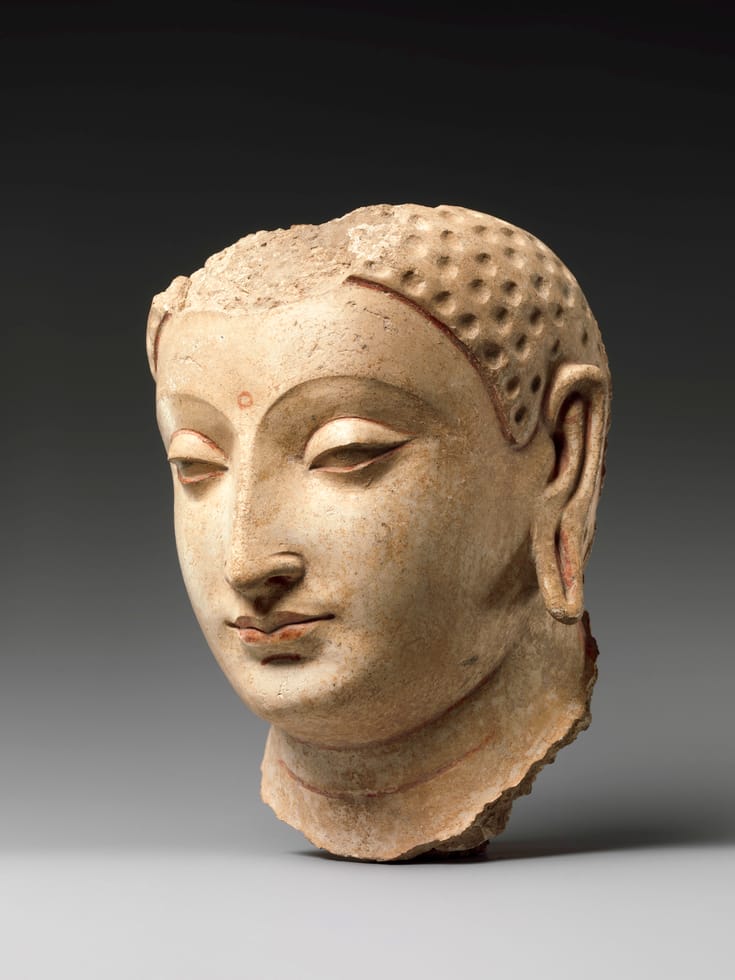
Head of Buddha. 5th-6th Century, Afghanistan. Stucco. Photo courtesy of The Met.
People imagine that to be enlightened is to exist blissed out all the time, but that'due south not the case. And achieving enlightenment doesn't necessarily happen all at once. Very just, enlightenment is defined as thoroughly perceiving the true nature of reality, and of ourselves.
Enlightenment is too described every bit perceiving buddhanature, which in Vajrayana and Mahayana Buddhism is the fundamental nature of all beings. One way to understand this is to say that the enlightenment of the Buddha is always nowadays, whether we are enlightened of information technology or not.
Enlightenment, then, is non a quality that some people have and others don't. To realize enlightenment is to realize what already is. Information technology's merely that near of u.s.a. are lost in a fog and can't see it.
Is There a Buddhist Bible?
Not exactly. For one matter, the several schools and denominations of Buddhism do not all employ the same canon of scriptures. A text esteemed past 1 schoolhouse may exist unknown in another.
Further, Buddhist scriptures are not considered to be the revealed words of a god that must be accepted without question. The Buddha taught us to have no teaching on authorization alone, but to investigate it for ourselves. The many sutras and other texts are there to guide u.s., not to indoctrinate us.
The of import indicate is that Buddhism is not something you believe, merely something you lot practice. It'due south a path of both personal subject area and personal discovery. People have walked this path for 25 centuries, and by at present there are plenty of directions, signposts and markers. And there are mentors and teachers for guidance, besides as many beautiful scriptures.
Boosted Reading
- "The Message of the Buddha'south Four Noble Truths," by Sylvia Boorstein
- "The Buddha is Nonetheless Education," by Jack Kornfield
- "I Can't Believe Information technology's Non Buddha!" by Bodhipaksa
- "Existent Buddha Quotes About Fake Buddha Quotes," past Bodhipaksa
- "seven Things the Buddha Never Said," past Thanissaro Bhikkhu
- "How to Meditate: The Complete Buddhist Guide," LionsRoar.com
- "The Buddha, A Moving-picture show by David Grubin," PBS.org
- "Access to Insight: Readings in Theravada Buddhism," AccessToInsight.org
- "84,000: Translating the Words of the Buddha," 84000.co
- "Buddhism for Beginners," LionsRoar.com
Source: https://www.lionsroar.com/who-was-the-buddha/
0 Response to "Where in the Bible Does It Say Modern Day Iraq Will Be Great Again"
Post a Comment